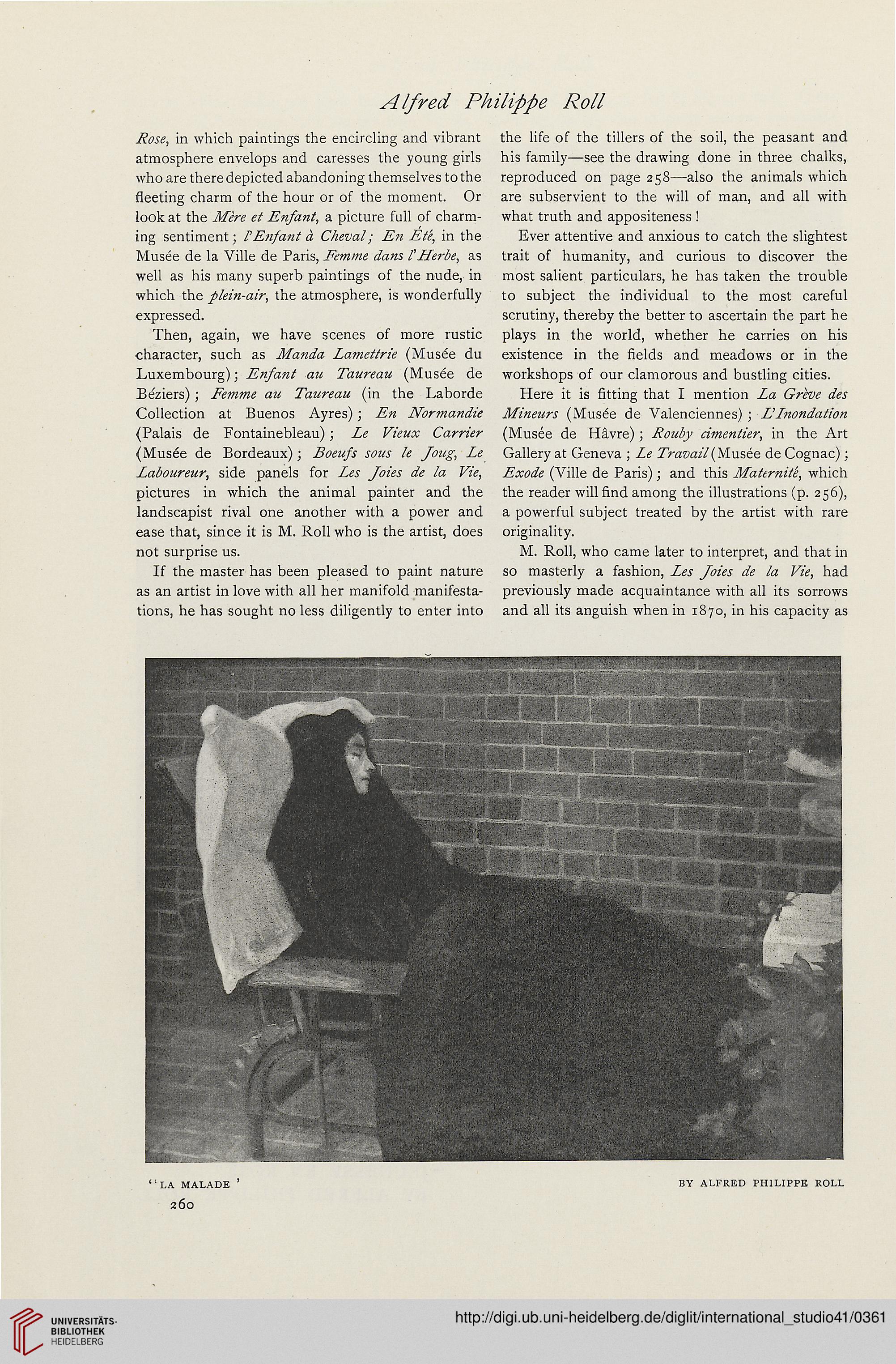Alfred Philippe Roll
Rose, in which paintings the encircling and vibrant the life of the tillers of the soil, the peasant and
atmosphere envelops and caresses the young girls his family—see the drawing done in three chalks,
who are theredepicted abandoning themselves to the reproduced on page 258—also the animals which
fleeting charm of the hour or of the moment. Or are subservient to the will of man, and all with
look at the Mere et Enfant, a picture full of charm- what truth and appositeness !
ing sentiment; 1'Enfant a Cheval; En Ete, in the Ever attentive and anxious to catch the slightest
Musee de la Ville de Paris, Esmme dans rHerbe, as trait of humanity, and curious to discover the
well as his many superb paintings of the nude, in most salient particulars, he has taken the trouble
which the plein-air, the atmosphere, is wonderfully to subject the individual to the most careful
expressed. scrutiny, thereby the better to ascertain the part he
Then, again, we have scenes of more rustic plays in the world, whether he carries on his
character, such as Manda Lamettrie (Musee du existence in the fields and meadows or in the
Luxembourg); Enfant an Taureau (Musee de workshops of our clamorous and bustling cities.
Be'ziers) ; Eemme au Taureau (in the Laborde Here it is fitting that I mention La Greve des
Collection at Buenos Ayres); En Normandie Mineurs (Musee de Valenciennes) ; L'Inondation
(Palais de Fontainebleau); Le Vieux Carrier (Musee de Havre); Rouby cimentier, in the Art
(Mus£e de Bordeaux); Boeufs sous le Joug, Le Gallery at Geneva ; Le Travail {^inste de Cognac) ;
Laboureur, side panels for Les Joies de la Vie, Exode (Ville de Paris); and this Matertiite, which
pictures in which the animal painter and the the reader will find among the illustrations (p. 256),
landscapist rival one another with a power and a powerful subject treated by the artist with rare
ease that, since it is M. Roll who is the artist, does originality.
not surprise us. M. Roll, who came later to interpret, and that in
If the master has been pleased to paint nature so masterly a fashion, Les Joies de la Vie, had
as an artist in love with all her manifold manifesta- previously made acquaintance with all its sorrows
tions, he has sought no less diligently to enter into and all its anguish when in 1870, in his capacity as
"LA MALADE ' BY ALFRED PHILIPPE ROLL
260
Rose, in which paintings the encircling and vibrant the life of the tillers of the soil, the peasant and
atmosphere envelops and caresses the young girls his family—see the drawing done in three chalks,
who are theredepicted abandoning themselves to the reproduced on page 258—also the animals which
fleeting charm of the hour or of the moment. Or are subservient to the will of man, and all with
look at the Mere et Enfant, a picture full of charm- what truth and appositeness !
ing sentiment; 1'Enfant a Cheval; En Ete, in the Ever attentive and anxious to catch the slightest
Musee de la Ville de Paris, Esmme dans rHerbe, as trait of humanity, and curious to discover the
well as his many superb paintings of the nude, in most salient particulars, he has taken the trouble
which the plein-air, the atmosphere, is wonderfully to subject the individual to the most careful
expressed. scrutiny, thereby the better to ascertain the part he
Then, again, we have scenes of more rustic plays in the world, whether he carries on his
character, such as Manda Lamettrie (Musee du existence in the fields and meadows or in the
Luxembourg); Enfant an Taureau (Musee de workshops of our clamorous and bustling cities.
Be'ziers) ; Eemme au Taureau (in the Laborde Here it is fitting that I mention La Greve des
Collection at Buenos Ayres); En Normandie Mineurs (Musee de Valenciennes) ; L'Inondation
(Palais de Fontainebleau); Le Vieux Carrier (Musee de Havre); Rouby cimentier, in the Art
(Mus£e de Bordeaux); Boeufs sous le Joug, Le Gallery at Geneva ; Le Travail {^inste de Cognac) ;
Laboureur, side panels for Les Joies de la Vie, Exode (Ville de Paris); and this Matertiite, which
pictures in which the animal painter and the the reader will find among the illustrations (p. 256),
landscapist rival one another with a power and a powerful subject treated by the artist with rare
ease that, since it is M. Roll who is the artist, does originality.
not surprise us. M. Roll, who came later to interpret, and that in
If the master has been pleased to paint nature so masterly a fashion, Les Joies de la Vie, had
as an artist in love with all her manifold manifesta- previously made acquaintance with all its sorrows
tions, he has sought no less diligently to enter into and all its anguish when in 1870, in his capacity as
"LA MALADE ' BY ALFRED PHILIPPE ROLL
260




